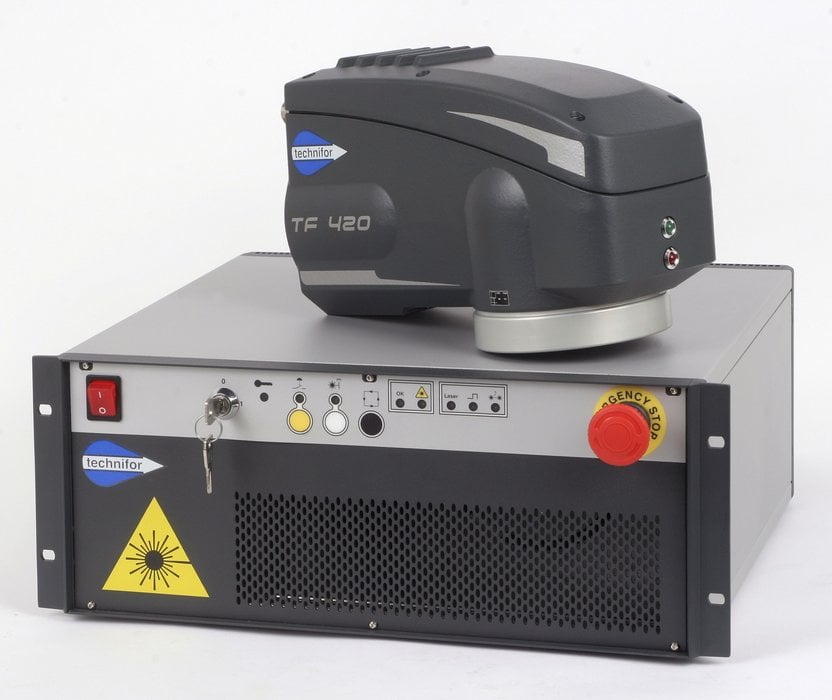www.industry-vietnam.com
09
'08
Written on Modified on
TF420, a very compact 20W laser marker
With the TF420 fibre laser marking solution, Technifor have brought out a unit that is twice as compact as the previous generations, while keeping the same marking quality level, and providing a writing speed of up to 2.5 m per second, and a skipping speed of up to 5 m/s. It is designed for applications involving medium to large production runs: motor vehicles, medical fields, electrical or mechanical components, etc.

The TF420 is in a class apart, mainly because of its ease of integration. Thanks to its light source operating at 1.06 mm (diode) placed remotely in the control unit, its latest-generation new electronics, and a reduced number of optical components, the marking head takes up a volume of just 10 cu. dm, i.e. only half that of the previous models (diode-pumped laser). The light beam travels to the marking head along an optical fibre. The remote control unit can be fitted in a 19’’ rack and it features an integrated buffer memory.
The TF420 also provides a longer service life and enhanced reliability. Firstly, the use of a fibre laser increases the diode service life to 100,000 hours, whereas beforehand, in the case of a diode-pumped laser, it was necessary to replace the diode every 10,000 hours of use. Secondly, the TF420 marking head and its control unit have been designed with the lowest possible number of optical elements (no Q-switch, no crystal, no RF driver), to reduce maintenance and avoid drift in the settings of the optical components, to ensure constant marking quality over time. Thirdly, an electronic safety system featuring a reflectivity alarm stops the laser if the reflection level from the part is too high, and prevents laser damage in the event of incorrect parameterization.
The TF420 marking solution includes the intuitive, ergonomic Technifor T700W marking program. Its interface enables users to program the simplest marking sequences in less than 5 clicks. It manages traceability data (serial number, variables, Data Matrix codes, bar codes, etc.) and it links up easily to production databases (ODBC, Excel, ASCII, etc.). Materials libraries with pre-programmed parameters are provided, together with generation of record files.
The TF420 system can be used to mark a wide range of materials, including plastics, metals, or ceramics, and also difficult surfaces such as cast aluminium, steel, or titanium. It provides many marking grades, because its range of operating frequencies is the widest on the market, varying from 20 to 100 kHz with a maximum energy level of 1 mJ.
Technifor provides an optional integration and customization aid, together with marking systems for samples or first articles of series.
TECHNIFOR
Alexia RAULIN
This email address is being protected from spambots. You need JavaScript enabled to view it.
The TF420 also provides a longer service life and enhanced reliability. Firstly, the use of a fibre laser increases the diode service life to 100,000 hours, whereas beforehand, in the case of a diode-pumped laser, it was necessary to replace the diode every 10,000 hours of use. Secondly, the TF420 marking head and its control unit have been designed with the lowest possible number of optical elements (no Q-switch, no crystal, no RF driver), to reduce maintenance and avoid drift in the settings of the optical components, to ensure constant marking quality over time. Thirdly, an electronic safety system featuring a reflectivity alarm stops the laser if the reflection level from the part is too high, and prevents laser damage in the event of incorrect parameterization.
The TF420 marking solution includes the intuitive, ergonomic Technifor T700W marking program. Its interface enables users to program the simplest marking sequences in less than 5 clicks. It manages traceability data (serial number, variables, Data Matrix codes, bar codes, etc.) and it links up easily to production databases (ODBC, Excel, ASCII, etc.). Materials libraries with pre-programmed parameters are provided, together with generation of record files.
The TF420 system can be used to mark a wide range of materials, including plastics, metals, or ceramics, and also difficult surfaces such as cast aluminium, steel, or titanium. It provides many marking grades, because its range of operating frequencies is the widest on the market, varying from 20 to 100 kHz with a maximum energy level of 1 mJ.
Technifor provides an optional integration and customization aid, together with marking systems for samples or first articles of series.
TECHNIFOR
Alexia RAULIN
This email address is being protected from spambots. You need JavaScript enabled to view it.

